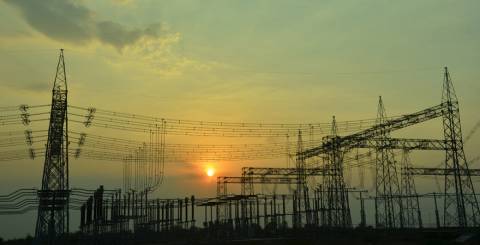How Does Power Transmission and Distribution System Work in Our Country?

Transmission networks responsible for power transmission and distribution system are known as power grids. The electrical power is generated at power plants and then transferred or transmitted to electrical substations. This electric transmission involves the bulk transfer of the electrical energy at very high voltage. This is quite different from electric distribution, which is usually the next step after electric transmission, and it involves the distribution of electricity from local substations to the customers. Multiple transmission lines interconnected with each other are referred to as transmission networks.
Electric transmission requires high-voltage transmission line and these are usually three-phase alternate current. Though in the case of railway electrification systems, sometimes single phase AC is used. Transmitting electricity over large distances can be a challenging and an expensive task. In order to achieve greater efficiency for transmitting electricity over long distances High-voltage direct current (HVDC) technology is used. With this technology, electricity can be efficiently transmitted over hundreds of kilometers. This same technology is also employed for transmission between power grids that are not synchronized with each other. HDVC is often used for power transmission and distribution system in order to prevent problems related to synchronization and cascading failures.
Electricity transmission happens at high voltage (115kV or above) to minimize the loss of energy during long distance transmission. There are two main ways of transmitting power over long distances; through overhead power lines or through underground power lines. The costs associated with underground power transmission and distribution system are high but it requires less maintenance as compared to overhead transmission lines. Underground transmission lines are often preferred in highly populated urban areas and environmentally delicate places.
Overhead Transmission
In overhead power transmission and distribution, the overhead conductors, which are usually made of aluminum alloys are used for high-voltage power transmission. These overhead conductors are woven into strands and reinforced with steel. These overhead conductors do not require any insulation. Aluminum is the preferred material for these overhead conductors because of its lightweight, reduced electric loss and cost effectiveness. Conductor sizes come in varying sizes, these can be as thin as 12 sq.mm and on the thicker side these can be up to 750 sq.mm. Surprisingly the current carrying capacity of thicker wires is only slightly more than the thinner wires because of the skin effect due to which the flow of current is confined to the outer surface of the wire only. In order to transmit higher load multiple parallel cables are bundled together for the purpose. These bundled conductors are employed at high voltages for minimizing energy losses. Overhead transmission wires use air for insulation and as a result certain minimum clearance level has to be taken into account for safety purposes.
For power transmission the voltage level is 110kV and above. There are lower voltage levels also, like 33kV and 66kV, which are sometimes employed for lighter loads. Voltages below than these levels are used for distribution purposes.
Underground Transmission
As an alternative to overhead electric transmission, the power transmission and distribution system can also be carried through underground power cables. Since the underground cables are secured below the ground surface these are not affected by adverse weather conditions and are also not visible like overhead transmission lines. The cost of laying underground power cables is much higher than that of overhead power lines since it requires ground excavation and insulating the ground cables. Although underground cables are not damaged as often as overhead lines but if a fault occurs it usually takes much longer to repair it for underground cables. Another drawback of underground cables is that these have less thermal capacity because of which they can take lesser overload than the overhead power lines. The capacitance is high for long underground AC cables which restricts these cables to carry power load to very long distances and are usually restricted to distances of 80 kms or less. But long underground DC cables do not suffer from any of these shortcomings and these can successfully laid over thousands of kilometers.
Similar Articles
Due to today's competitive environment, small businesses have a hard time distinguishing themselves from their numerous rivals in today's market. One key factor that defines their fate usually is branding
Looking to start a profitable small business? Discover 5 laser engraved products that are in high demand. These ideas are perfect for those seeking a creative and rewarding venture.
It’s crucial to target more skincare users as it can contribute to business expansion along with sales growth. As competition rises in the skincare sector, identifying ways to engage consumers is critical as the market grows stiff. These are some best practices that may be of great help in attracting new skincare clients and keeping them coming back for more.
Does your business send out physical goods frequently? How much do you think about their impact on your business' reputation, customer experience, and overall efficiency?
Simplify your small business's IT setup with our easy-to-understand guide on server racks.
In the world of business, protection against potential fraud or crime is mandatory. Being one of the significant business aspects, unsecured companies are likely to fall into financial pitfalls, leading to tainted reputations and heavy fines
Plastic strapping machines are pivotal in enhancing the efficiency of packaging operations across various industries. These machines automate the process of applying a strap to consolidate, hold, or secure products, ensuring that they are transported safely and remain intact during shipping.
A merchant cash advance (MCA) is a form of business financing that provides fast access to capital for small businesses and startups. MCAs allow companies to receive a lump sum of cash upfront in exchange for a percentage of future credit card and/or debit card sales over a fixed period.
Woodworking businesses specialize in crafting items from wood, ranging from furniture and cabinetry to decorative pieces and custom creations. These businesses often combine traditional craftsmanship with modern techniques to produce high-quality, bespoke products tailored to the needs and preferences of their clients









